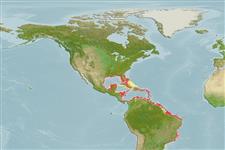Teleostei (teleosts) >
Carangaria/misc (Various families in series Carangaria) >
Centropomidae (Snooks)
Etymology: Centropomus: Greek, kentron = sting + Greek, poma, -atos = cover, operculum (Ref. 45335).
Environment: milieu / climate zone / depth range / distribution range
Ecology
Marine; brackish; demersal. Tropical; 32°N - 35°S
Western Atlantic: eastern Mexico and Greater Antilles to Venezuela and Porto Alegre in Brazil.
Size / Weight / Age
Maturity: Lm ? range ? - ? cm
Max length : 47.5 cm TL male/unsexed; (Ref. 5217); common length : 35.0 cm TL male/unsexed; (Ref. 5217)
Occurs in mouths of rivers and the littoral zone; spawns on banks; feeds on small fish and crustaceans (Ref. 35237). Juveniles bear conspicuous black tip on the dorsal fin and often join foraging groups of similarly sized and looking flagfin mojarras, Eucinostomus melanopterus. The snooks mingle with the mojarras and prey on fishes and shrimps attracted to the digging activity of the mojarras. The resemblance to a fish harmless to shrimps and small fishes allows the snook to approach this otherwise wary prey, an example of aggressive mimicry (Ref. 43465).
Life cycle and mating behavior
Maturities | Reproduction | Spawnings | Egg(s) | Fecundities | Larvae
Spawn in banks. Juveniles frequent in mangrove areas and flood zones (Ref. 35237).
Cervigón, F., R. Cipriani, W. Fischer, L. Garibaldi, M. Hendrickx, A.J. Lemus, R. Márquez, J.M. Poutiers, G. Robaina and B. Rodriguez, 1992. Fichas FAO de identificación de especies para los fines de la pesca. Guía de campo de las especies comerciales marinas y de aquas salobres de la costa septentrional de Sur América. FAO, Rome. 513 p. Preparado con el financiamento de la Comisión de Comunidades Europeas y de NORAD. (Ref. 5217)
IUCN Red List Status (Ref. 130435)
Threat to humans
Harmless
Human uses
Fisheries: commercial; gamefish: yes
Tools
Special reports
Download XML
Internet sources
Estimates based on models
Preferred temperature (Ref.
123201): 26.1 - 28.2, mean 27.4 °C (based on 687 cells).
Phylogenetic diversity index (Ref.
82804): PD
50 = 0.5005 [Uniqueness, from 0.5 = low to 2.0 = high].
Bayesian length-weight: a=0.00851 (0.00404 - 0.01792), b=3.05 (2.88 - 3.22), in cm total length, based on LWR estimates for this Genus-body shape (Ref.
93245).
Trophic level (Ref.
69278): 4.0 ±0.67 se; based on food items.
Resilience (Ref.
120179): Medium, minimum population doubling time 1.4 - 4.4 years (tm=3-4; Fec=800,000).
Fishing Vulnerability (Ref.
59153): Moderate vulnerability (38 of 100).
Nutrients (Ref.
124155): Calcium = 117 [70, 193] mg/100g; Iron = 0.939 [0.635, 1.422] mg/100g; Protein = 19.2 [16.9, 21.4] %; Omega3 = 0.25 [0.11, 0.55] g/100g; Selenium = 38.9 [21.7, 71.0] μg/100g; VitaminA = 23.2 [9.8, 54.9] μg/100g; Zinc = 1.25 [0.96, 1.68] mg/100g (wet weight);
